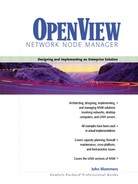Introduction
The configuration management NNM provides may be broadly divided into five basic areas:
discover IP addressable devices (as well as IPX and layer 2 devices), the network IP structure, routers, switches, bridges, repeaters, and other infrastructure devices
collect and store configuration information about devices and networks in a database
check the configuration information for changes, errors, or inconsistencies
present the network topology and device connectivity using a map hierarchy with IP-centric views, layer 2 views, or physical connectivity views
report the information by providing search capabilities to locate where devices appear in the network relative to the neighboring topology, and by offering text-based reporting tools
It’s also instructive to examine the seven-layer OSI model and identify information NNM collects at each layer, as shown in Table 7-1.
| Layer | Description | Information NNM Collects at This OSI Layer |
|---|---|---|
| 7 | Application | HTTP, SNMP, telnet, FTP, and other services (by testing well-known ports). |
| 6 | Presentation | n/a |
| 5 | Session | n/a |
| 4 | Transport | TCP connections (by reading the TCP section of the standard MIB) and UDP/TCP listeners. |
| 3 | Network | IP address, netmask, routing table, and other parameters from the IP section of the standard MIB. IPX information is also available. NNM also identifies layer 3 devices such as routers and assigns devices into subnets according to their IP address and netmask. |
| 2 | Link | MAC address, MTU, and other information (using the interfaces section of the standard MIB). NNM also identifies layer 2 devices such as switches and bridges and shows connections between switches and devices on their segments. |
| 1 | Physical | Type of interface such as Ethernet, Token Ring, and HSSI (using the interfaces section of the standard MIB). |
NNM provides many tools to support configuration management. One of the best ones is the configuration alarms category. Clues about configuration problems on the network abound in this category.
The ovtopodump command lets the network manager create lists of information about network devices and objects, both detailed and concise.
The map is NNM’s best tool for showing the most important configuration information of all, namely the network topology. It organizes the topology according to network, subnet, segment, and device. Map navigation is easy and device information can be obtained either from the menu bar or via pop-up menus.
NNM displays interface information graphically and offers both a menu bar and pop-up menus to display detailed technical data about each interface.
When the standard NNM menus don’t provide the degree of customized data required, the NNM system administrator may create local MIB applications and assign them to any desired position in the menu bar.
